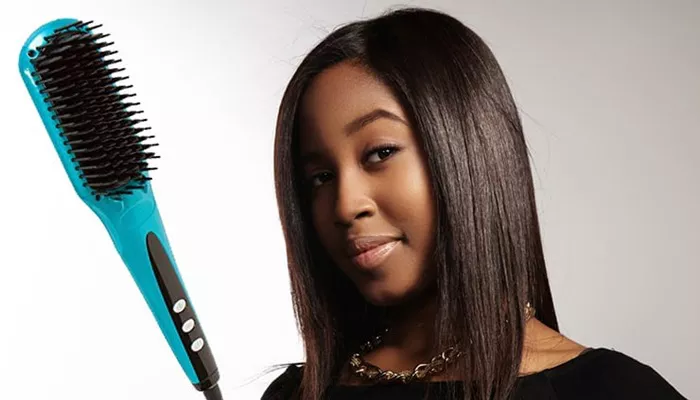Black natural hair, especially Type 4 textures (4a, 4b, 4c), has a unique structure defined by tight coils, high porosity, and fragile cuticles. These characteristics make it prone to dryness and breakage when exposed to heat. Straightening this hair type isn’t just about applying heat—it’s about understanding how to manipulate its natural pattern without stripping moisture or weakening the protein bonds. Unlike straight or wavy hair, Type 4 hair requires a careful balance of hydration, heat protection, and controlled tension. The goal is to temporarily relax the coils into a smooth, straight style while preserving the hair’s ability to revert to its natural state.
Before styling, evaluate your hair’s health. Signs of damage—such as split ends, excessive shedding, or a “straw-like” texture—mean you should postpone heat and focus on deep conditioning. Invest in tools designed for coarse textures: a flat iron with titanium plates (for even heat distribution) and a blow dryer with a comb attachment. Avoid using narrow combs or fine-tooth brushes, as they can snag and tear delicate strands.
Pre-Styling Prep: Building a Strong Foundation
The secret to sleek, long-lasting straight hair starts long before you turn on the flat iron. Begin with a clarifying shampoo to remove product buildup, dirt, and oils that block heat penetration. Follow with a moisturizing conditioner containing shea butter, avocado oil, or hydrolyzed wheat protein. These ingredients temporarily smooth the hair cuticle and add elasticity, reducing the risk of breakage during styling. For severely dry hair, apply a leave-in conditioner or pre-poo treatment overnight before washing.
After rinsing, gently detangle hair in sections using a wide-tooth comb or your fingers. Never detangle dry hair—this causes unnecessary stress. Pat hair dry with a microfiber towel to minimize frizz, then apply a heat protectant. Look for formulas with silicones like cyclopentasiloxane, which create a protective barrier without weighing hair down. Divide hair into 6–8 sections using clips, and blow-dry on medium heat with tension from the comb attachment. This stretches the hair, reducing the amount of direct heat needed later.
The Flat Iron Method: Step-by-Step for Glass-Like Smoothness
Section Strategically: Work in small subsections (1–2 inches wide) to ensure even heat distribution. Start at the nape, where hair is most resilient.
Temperature Control: Set your flat iron to 300–350°F for fine or color-treated hair, 360–380°F for medium textures, and 380–400°F for coarse, thick hair. Test a small section first—if it sizzles or smells burnt, lower the heat.
Slow and Steady: Clamp the iron close to the roots without touching the scalp. Glide it down the hair shaft in one smooth motion, maintaining consistent pressure. Avoid going over the same section more than twice.
Edge Care: For baby hairs or edges, use a smaller iron (1/2 inch) and a light hand. Wrap the hair around the iron in a rolling motion for a polished finish.
Post-straightening, run a boar bristle brush through your hair to distribute natural oils and enhance shine. Avoid heavy products like gels or creams, which can revert the style in humidity.
Post-Styling Maintenance: Keeping Hair Straight for Days
Straightened Type 4 hair is highly sensitive to moisture. To prevent reversion (poofing), sleep on a silk pillowcase and wrap hair in a silk scarf or bonnet. In the morning, refresh roots with a lightweight dry shampoo and smooth flyaways with a drop of serum. For workouts, tie hair into a loose braid or bun to minimize sweat exposure. If humidity strikes, apply a humidity-blocking spray and use your flat iron on the lowest setting (300°F) to reseal the cuticle.
Hydrate ends daily with a water-free moisturizer containing ceramides or jojoba oil. These ingredients mimic natural oils without reactivating curls. Avoid touching your hair excessively—oils from your hands can transfer and cause frizz.
Critical Mistakes That Destroy Hair Health
Skipping Heat Protectant: Direct heat on unprotected hair melts the cuticle, leading to permanent porosity and breakage.
Overlapping Heat Passes: Repeatedly ironing the same spot thins the hair shaft. One to two passes max!
Ignoring Tool Hygiene: Dirty flat irons transfer product residue, causing uneven heat and buildup. Clean plates weekly with rubbing alcohol.
Using High Heat on Fine Hair: Thin strands can’t withstand 400°F—adjust settings based on your hair’s thickness.
Styling Dirty Hair: Product buildup blocks heat penetration, forcing you to use higher temperatures.
If your hair feels rough, looks dull, or snaps easily after straightening, take a 6–8 week heat hiatus. Focus on protein treatments (like aphogee) and moisture masks to rebuild strength.
Heat-Free Alternatives for Temporary Straightening
For those avoiding heat damage, try these methods:
Tension Blowouts: Use a blow dryer and round brush to stretch hair. Focus on tension, not heat.
Roller Sets: Wrap damp hair around magnetic rollers and sit under a hooded dryer. Results last up to 2 weeks.
Band Ponytails: Divide hair into sections, secure with hair ties every 2 inches, and let air-dry. Releases natural stretch.
When to Visit a Professional Stylist
If home styling leads to frizz, uneven results, or breakage, seek a stylist specializing in Type 4 hair. They may recommend:
Keratin Treatments: A semi-permanent straightening option (lasts 3–5 months). Opt for formaldehyde-free formulas.
Silk Press Services: Combines deep conditioning, blowouts, and precision flat ironing for salon-level smoothness.
Custom Trims: Removing split ends ensures healthier heat styling in the future.
Conclusion
Straightening Type 4 hair can be safe, but it demands discipline. Always prioritize moisture-protein balance, moderate heat, and regular trims. Remember, no amount of straightening is worth sacrificing your hair’s natural resilience. Embrace protective styles like braids or twists between heat sessions, and never let aesthetics override the need for healthy strands. With these strategies, you’ll enjoy sleek, straight hair that thrives—even when the curls return.
Related topics:
How to Style Short Permed Black Hair
12 Ways to Style Short Black Hair, According to Hairstylists


